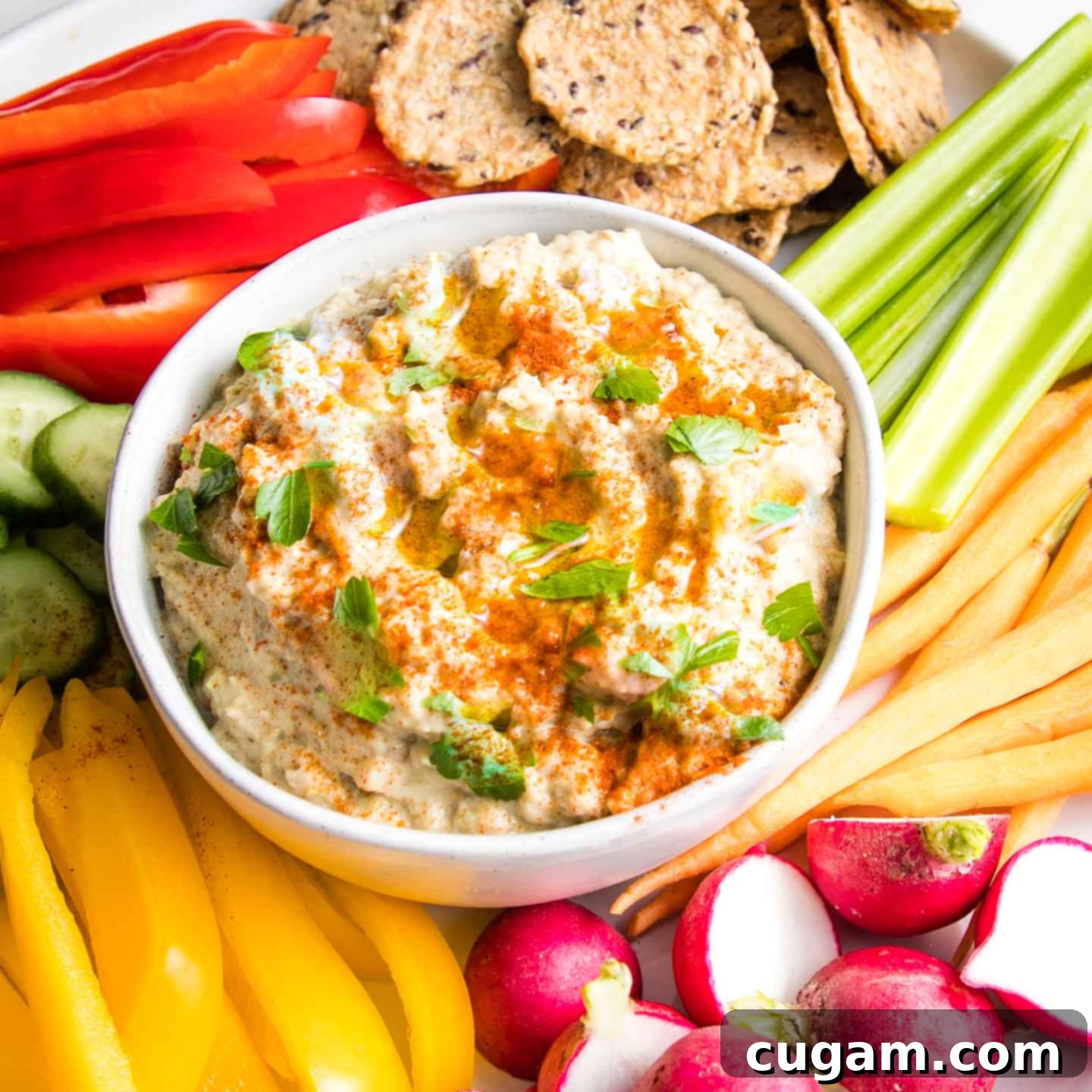The Best Homemade Baba Ganoush: A Creamy Roasted Eggplant Dip with Roasted Garlic & Caramelized Veggies
Prepare to elevate your culinary experience with this extraordinary recipe for Baba Ganoush, a traditional Middle Eastern roasted eggplant dip that’s surprisingly easy to make at home. What truly sets this version apart and makes it “THE BEST” is the meticulous addition of rich, deeply flavored roasted garlic combined with sweet, caramelized onions and celery. This unique blend transforms humble eggplant into a vibrant, complex, and utterly irresistible spread. Boasting a naturally dairy-free and luxuriously creamy texture thanks to tahini and fresh lemon juice, it’s a healthy vegan snack or appetizer that perfectly complements any Mediterranean-inspired meal. Get ready to dip, spread, and savor!
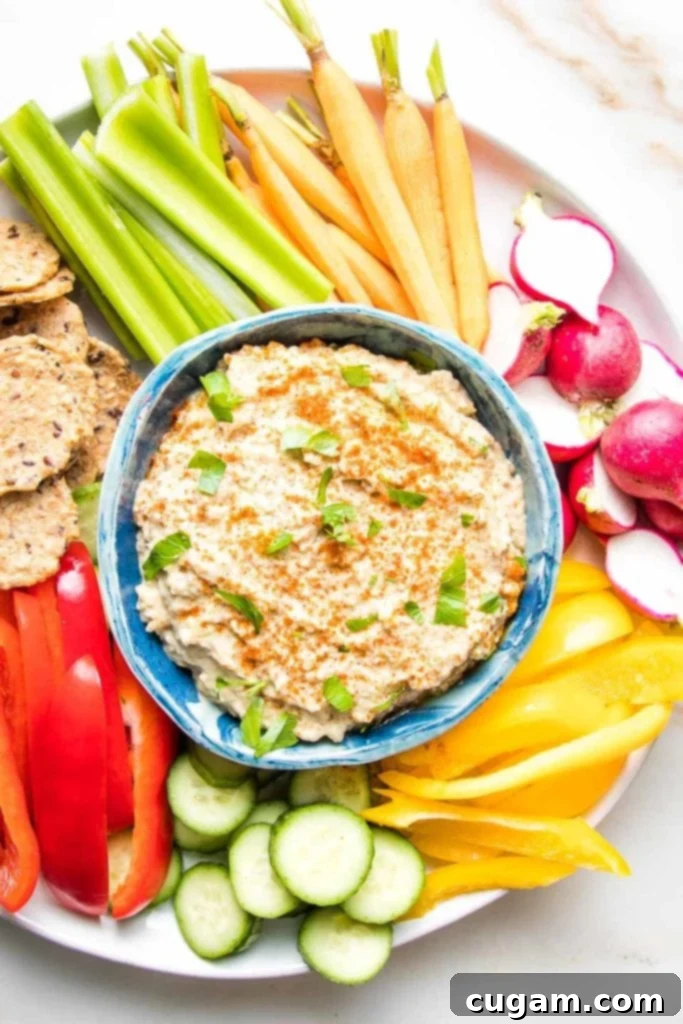
Baba Ganoush vs. Hummus: Why This Roasted Eggplant Dip Wins Every Time
The culinary world often finds itself in a delightful debate: Baba Ganoush versus the ever-popular Hummus. While hummus often takes center stage, I wholeheartedly champion Team Baba Ganoush, especially when it’s crafted with care and the right ingredients. It might be the less common choice for some, but I assure you, a properly prepared Baba Ganoush offers a depth of flavor and a silky texture that stands proudly on its own. As eggplant season flourishes, there’s no better time to explore this incredibly healthy and undeniably delicious dip. Give this recipe a try, and you might just find yourself switching sides in this delicious debate!
This superior Baba Ganoush, distinguished by its foundation of perfectly roasted eggplant and tender, sweet roasted garlic, is more than just a dip. It’s an essential component for any vibrant mezze platter, serving as a versatile accompaniment for everything from crisp crudités and warm pita bread to more elaborate dishes. Imagine it alongside flavorful cauliflower shawarma, savory tofu shawarma, crispy baked falafel, refreshing dairy-free tzatziki, briny olives, and tender roasted carrots. Each bite offers a harmonious blend of textures and authentic Mediterranean flavors, making your gathering truly special.
Key Ingredients for the Perfect Baba Ganoush
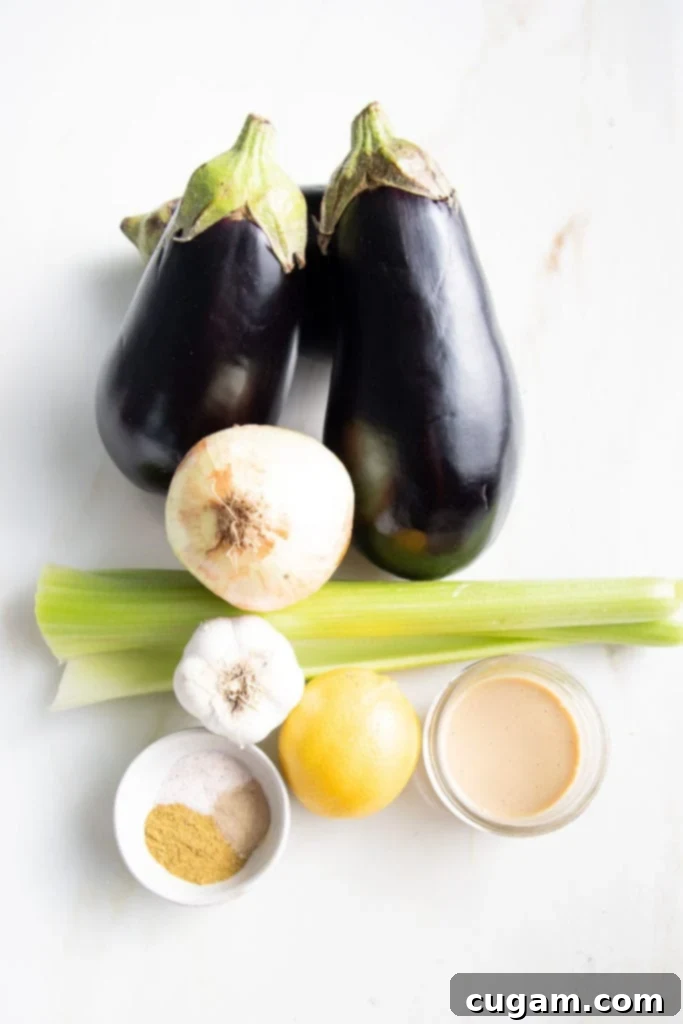
Each ingredient in this Baba Ganoush recipe plays a crucial role in building its exceptional flavor and creamy texture. Here’s a closer look at what makes them so special:
- Eggplant: The star of our show! You’ll need about 2 pounds, which typically translates to one large, two medium, or three smaller eggplants. I highly recommend opting for smaller eggplants if available, as they tend to cook more quickly and possess a naturally less bitter flavor, resulting in a sweeter, more tender dip. The roasting process is key here, transforming the firm flesh into a smoky, melt-in-your-mouth base.
- Roasted Garlic: This is a game-changer. Roasting garlic mellows its intense pungency, taking away the “bite” and bringing forth a wonderfully smooth, sweet, and nutty flavor profile. This transformation not only makes the garlic easier to digest for some but also allows you to incorporate more of this aromatic ingredient, enriching the overall depth of the Baba Ganoush. Beyond flavor, garlic is celebrated for its anti-inflammatory, antioxidant, and vitamin-rich properties.
- Tahini: Essential for that authentic, creamy, and dairy-free texture. Tahini, a paste made from ground sesame seeds, adds a distinct nutty and slightly earthy flavor that is indispensable in Middle Eastern dips. Unlike mayonnaise, which offers little in terms of health benefits beyond fat, tahini contributes healthy fats, protein, and essential minerals, making this a truly wholesome dip.
- Fresh Lemon Juice: The bright, zesty notes of fresh lemon juice are vital for balancing the richness of the tahini and eggplant. It cuts through the flavors, preventing the dip from tasting heavy and adding a refreshing tang that elevates the entire profile. I prefer to rely on lemon for brightness rather than excessive oil or salt.
- Caramelized Onions & Celery: This is a secret weapon that truly sets this Baba Ganoush apart. While eggplant can sometimes be a bit bland on its own, sautéing onions and celery until they are beautifully caramelized infuses the dip with a profound sweetness and savory depth. These tender, golden-brown veggies are authentic flavor builders, adding a layer of complexity you won’t find in standard recipes.
- Spices (Cumin, Sea Salt, White Pepper): Ground cumin provides that warm, earthy, and distinctly Middle Eastern aroma. Coarse sea salt enhances all the natural flavors, while a touch of white pepper adds a subtle, refined heat without being overpowering. These spices complete the flavor profile, making the dip truly irresistible.
The Art of Roasting Eggplant & Garlic for Maximum Flavor
This critical step is truly where our Baba Ganoush recipe begins to shine, unlocking a depth of flavor that’s unmatched by any other method. While your oven is already preheating, it’s the perfect opportunity to roast both the eggplant and the garlic simultaneously – an efficient and flavor-boosting technique. Trust me, you’ll want to roast a little extra garlic; its sweet, mellow notes are incredibly versatile and delicious in many other dishes.
Roasting the garlic cloves with their skins on serves a crucial purpose: it acts as a natural protective barrier, shielding the delicate flesh from burning while allowing it to soften and caramelize beautifully. Once roasted to perfection, the garlic cloves become incredibly tender, making it effortless to squeeze the sweet pulp directly into your food processor. For many, raw garlic can be a trigger for heartburn or acid reflux, but the roasting process magically tames these compounds, making it much easier to digest without sacrificing any of its incredible flavor or health benefits. Indeed, garlic is a powerhouse of nutrition, packed with anti-inflammatory compounds, potent antioxidants, and essential vitamins, contributing not just taste but also wellness to this delightful dip.
For the eggplant, roasting achieves a smoky, tender interior that is essential for the characteristic texture of Baba Ganoush. The high heat of the oven draws out moisture, concentrates the eggplant’s natural sugars, and imbues it with that signature smoky aroma that forms the backbone of this classic dip. It’s an indispensable step for achieving the truly authentic taste.
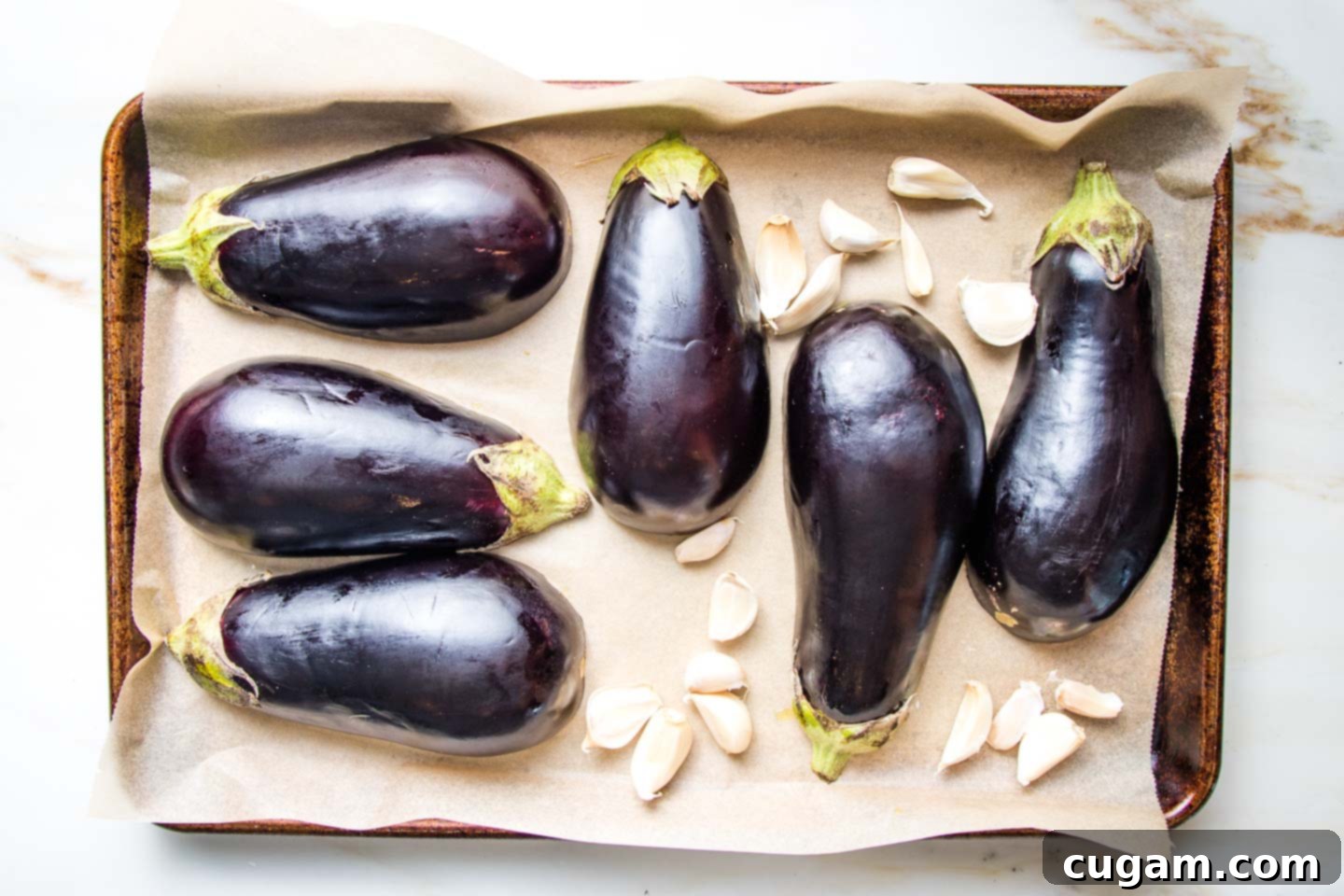
Halve eggplant, drizzle cut side with olive oil and turn it skin side up on a parchment lined baking sheet. Scatter garlic cloves with their skins on the pan.
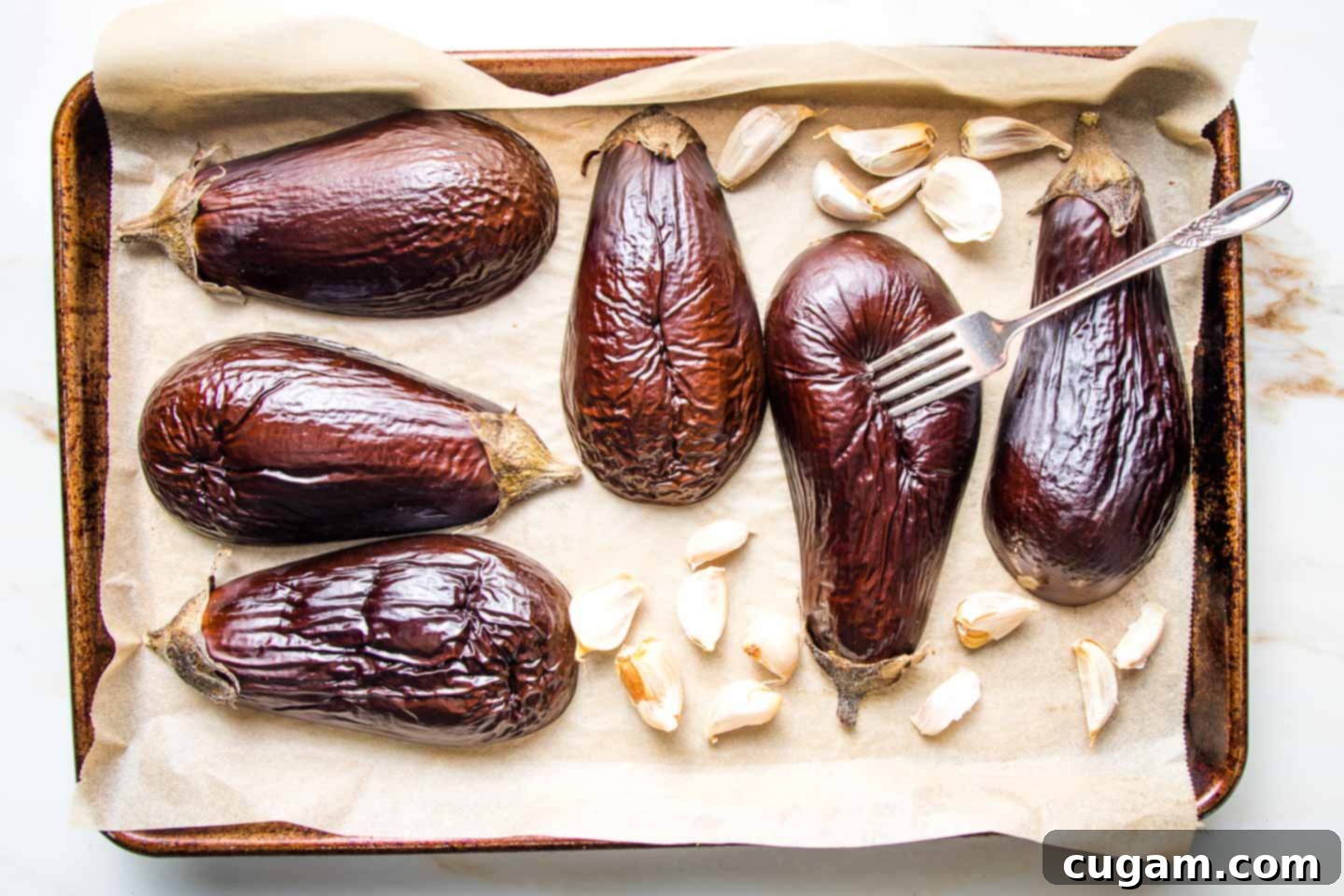
Roast in preheated 400 degree oven. This could take 30-40 minutes, depending on how large your eggplants are. You’ll know the eggplant is done when tender to a fork piercing.
Enhancing Flavor: Caramelizing Onions and Celery
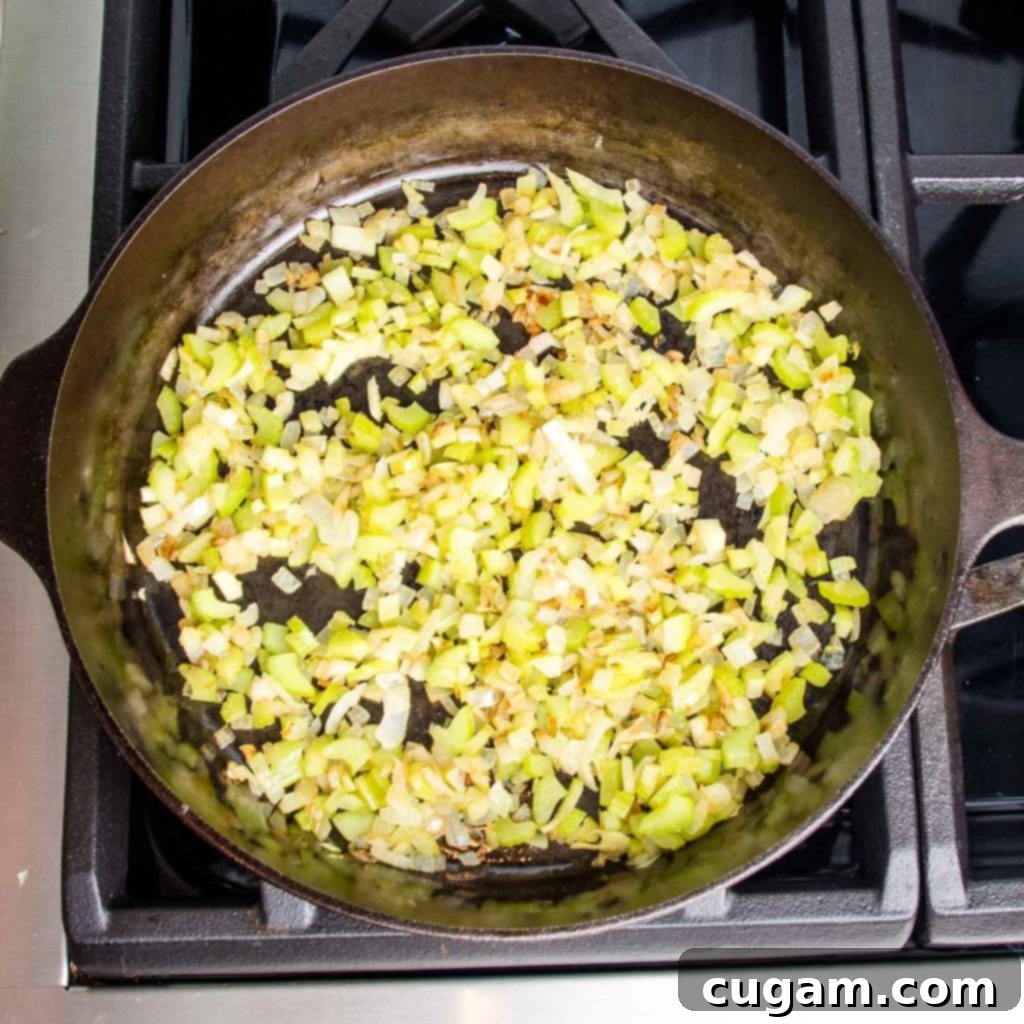
While your eggplant and garlic are roasting to perfection in the oven, you can multitask by preparing the aromatic foundation of this exquisite dip: caramelized onions and celery. This step is a secret weapon, adding an incredible depth of savory sweetness that elevates the Baba Ganoush beyond a simple dip.
Begin by finely chopping your onions and celery. Then, in a sturdy cast iron skillet or a heavy-bottomed pan, swirl in the remaining olive oil over a medium-low heat. The key to successful caramelization is patience and a gentle heat. A lower temperature ensures that the onions and celery slowly soften, release their natural sugars, and develop a beautiful golden-brown hue without burning. This slow cooking process, typically taking about 8-10 minutes, transforms the vegetables, concentrating their flavors into a rich, sweet, and savory essence that will perfectly complement the smoky eggplant.
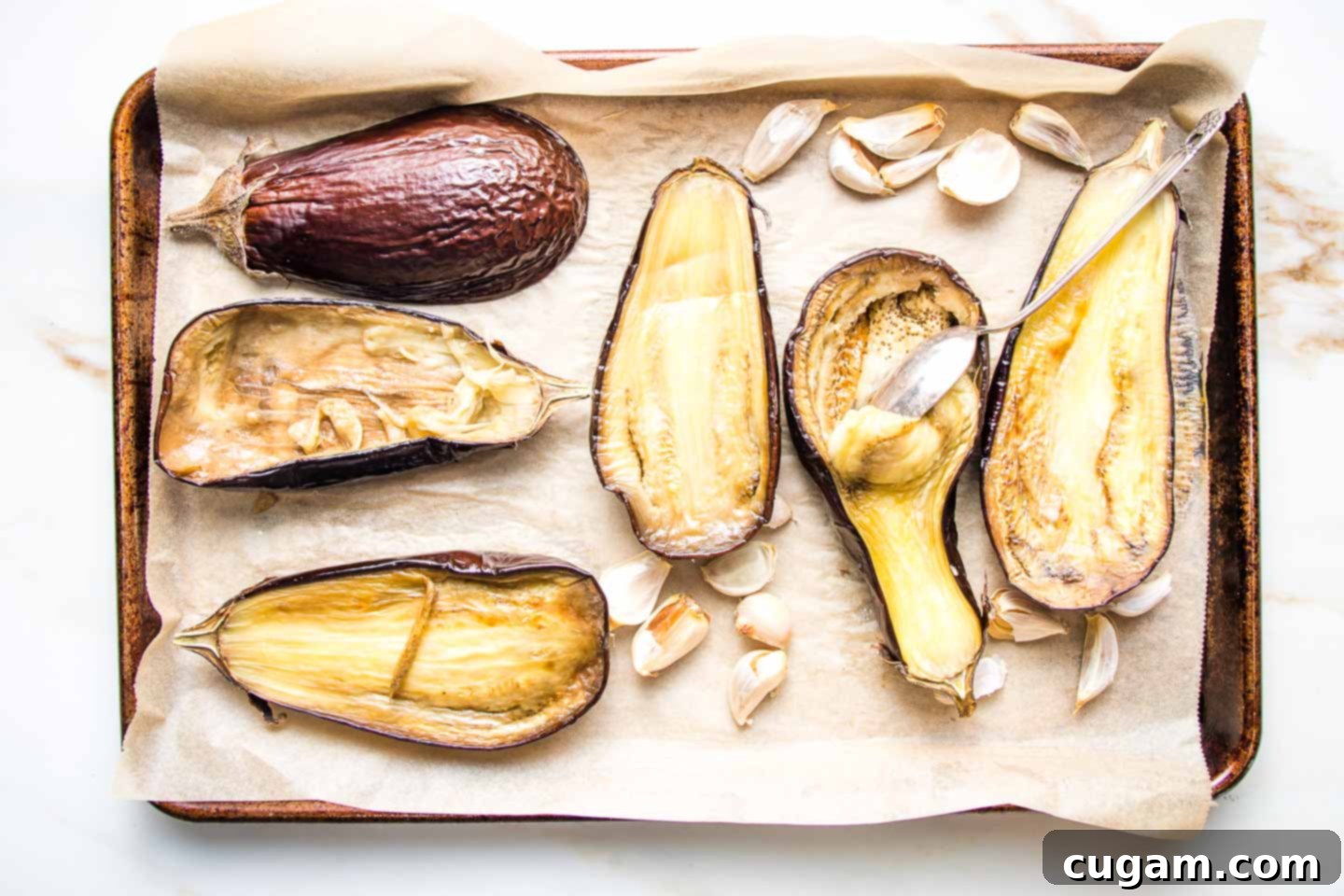
Once the eggplant is fully roasted and cool enough to handle, its sides will have caved in, and the flesh will be incredibly tender when pierced with a fork. Using a large spoon, carefully scoop the smoky, soft eggplant pulp directly into the bowl of your food processor. Next, gently squeeze the softened roasted garlic cloves from their skins, adding their sweet, mellow goodness to the processor as well. These perfectly cooked ingredients are now ready for the next step in creating your ultimate Baba Ganoush.
Crafting Your Creamy Baba Ganoush: Step-by-Step
Once your eggplant and garlic are beautifully roasted, and your onions and celery are perfectly caramelized, the process of bringing this incredible Baba Ganoush together is wonderfully simple. While a food processor is ideal for achieving a perfectly smooth consistency, don’t worry if you don’t have one. A blender can also work effectively, or for a more rustic, chunky texture, simply mash everything by hand with a potato masher – the taste will still be exceptional!
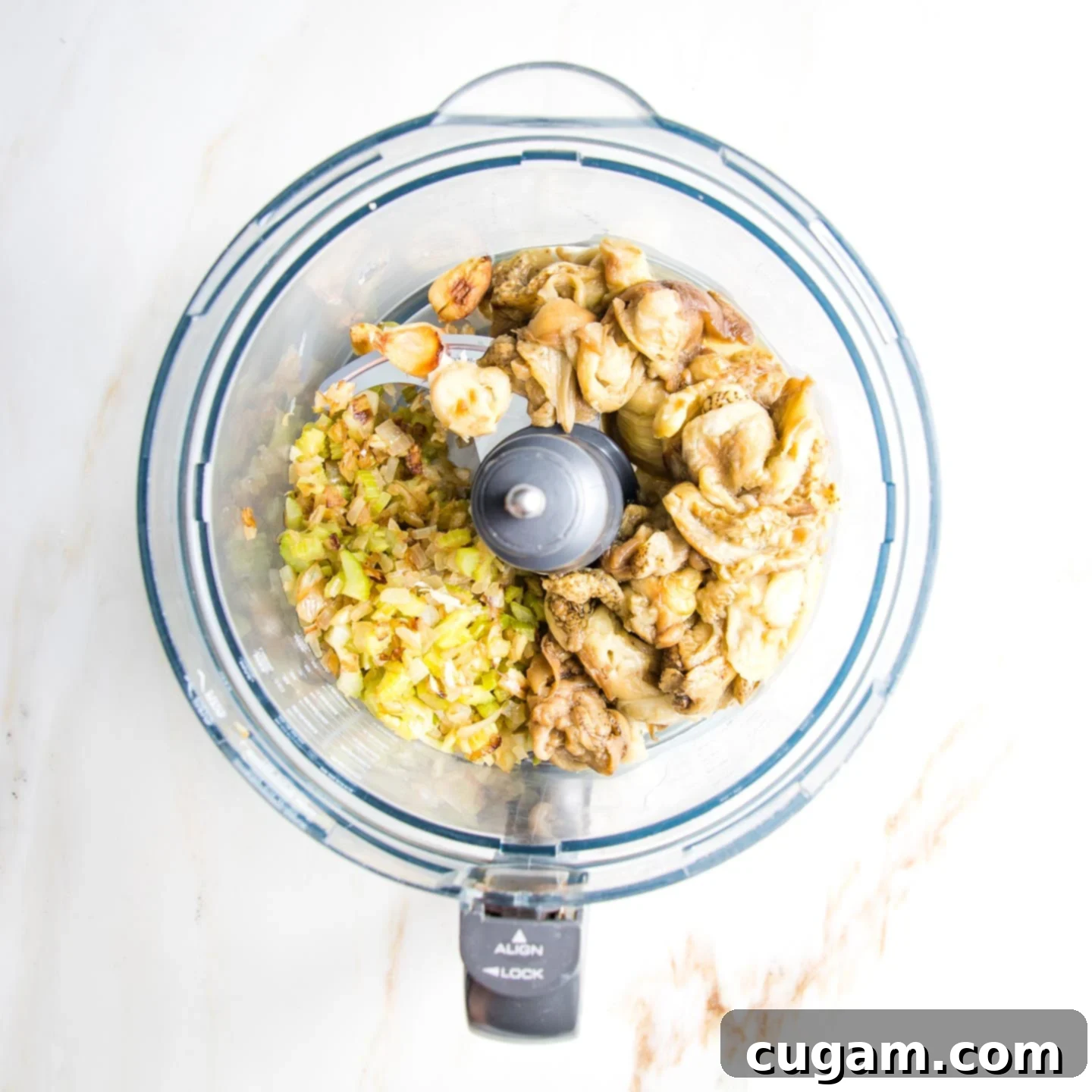
First, carefully transfer all your prepped ingredients—the wonderfully tender roasted eggplant pulp, the sweet roasted garlic, and the fragrant caramelized onions and celery—into the bowl of your food processor. Ensure all components are cool enough to handle before processing.
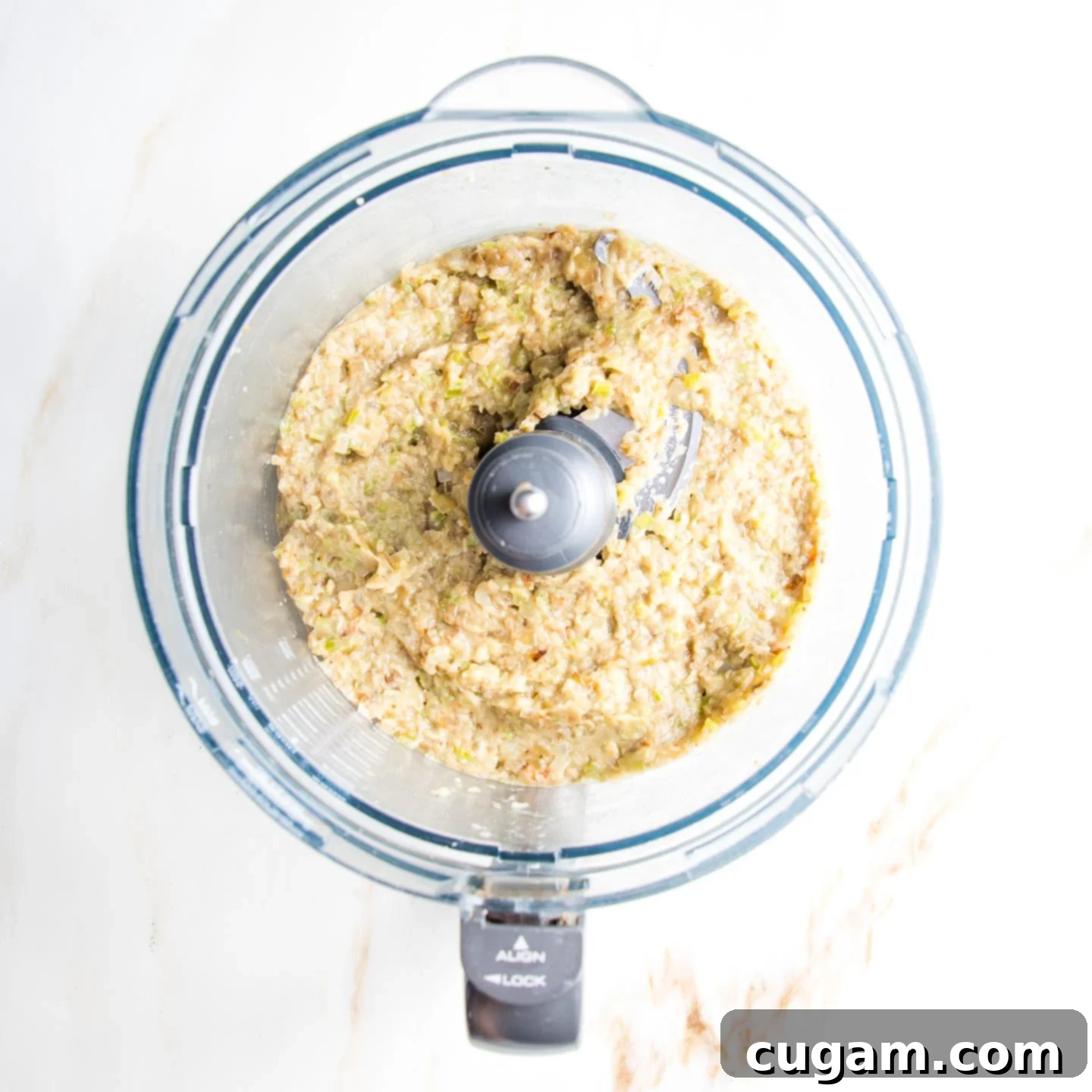
Begin by pulsing the mixture a few times. This initial step will break down the larger chunks and start to combine the flavors, creating a somewhat chunky base. You’re aiming for a coarse texture at this stage, before adding the wet ingredients.
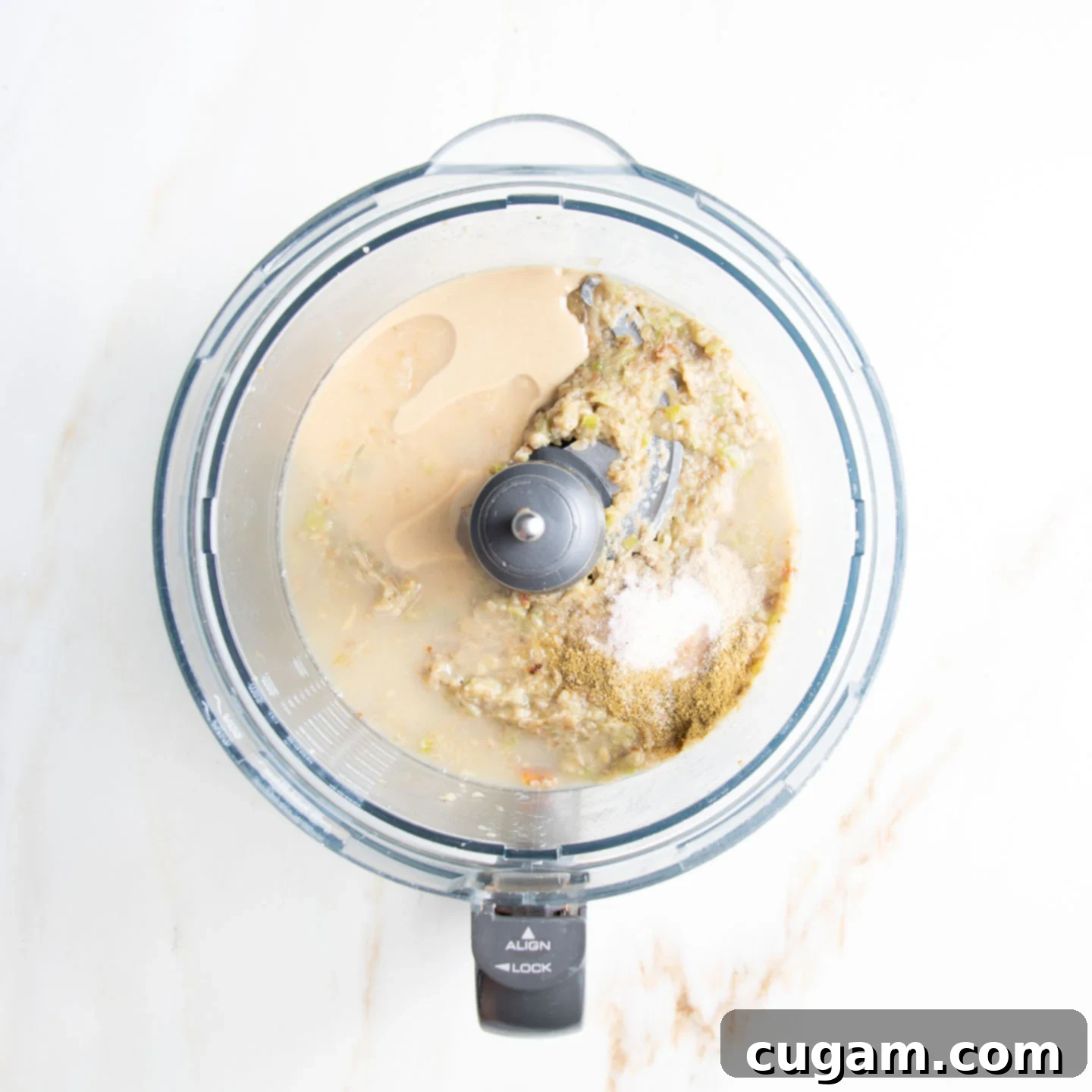
Now, it’s time to introduce the foundational liquid ingredients and spices. Add the creamy tahini, freshly squeezed lemon juice, earthy ground cumin, coarse sea salt, and a pinch of white pepper to the eggplant mixture in the food processor. These additions are crucial for developing the characteristic flavor and smooth consistency of Baba Ganoush.
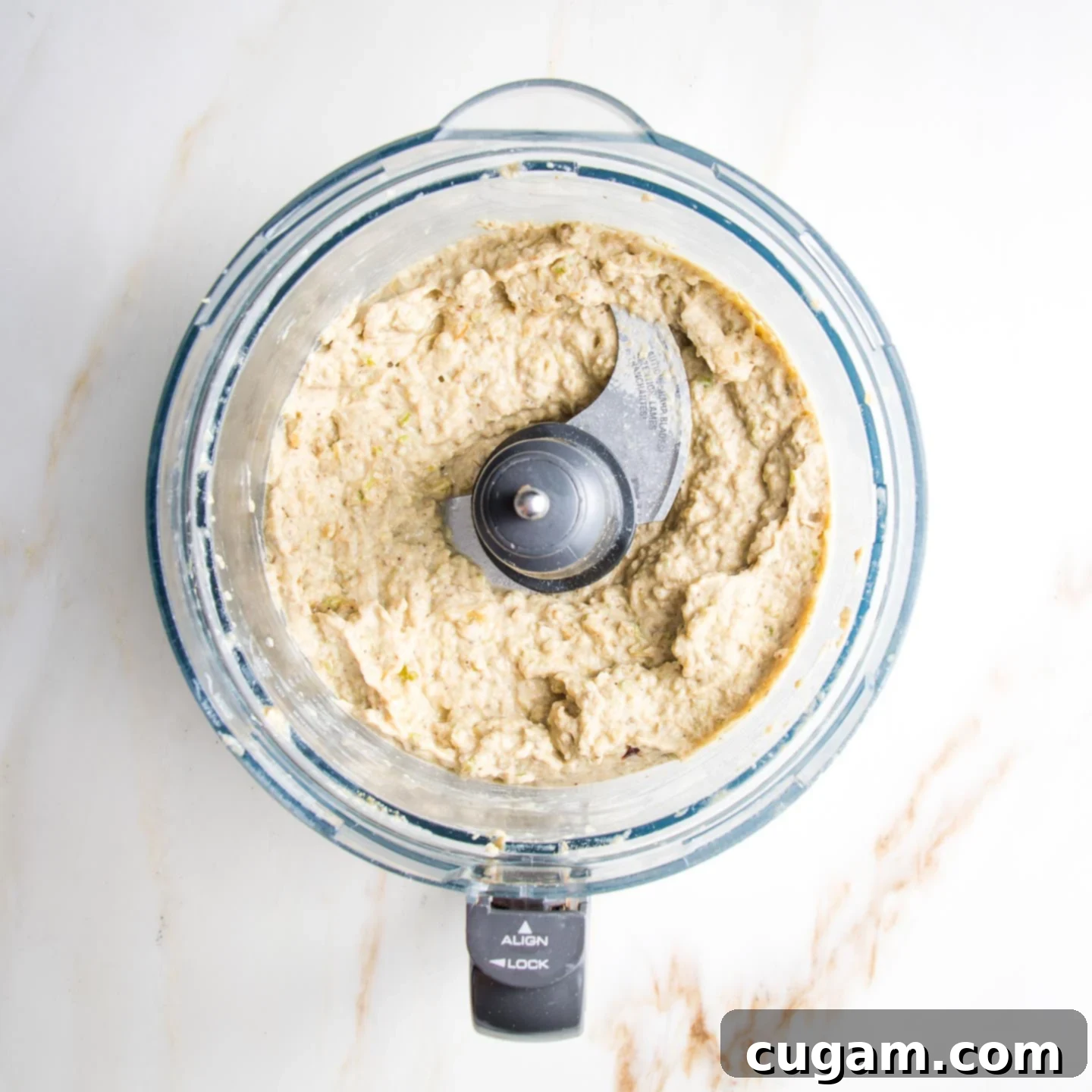
Process the mixture continuously, pausing periodically to scrape down the sides of the bowl with a spatula. This ensures all ingredients are thoroughly incorporated and blended evenly. Continue processing until your Baba Ganoush reaches your desired creamy, smooth consistency. Some prefer it perfectly silken, while others enjoy a slight bit of texture. Adjust the processing time to your personal preference, tasting and adjusting seasonings as you go. For a thinner dip, a touch more lemon juice or a tablespoon of water can be added; for a thicker consistency, a bit more tahini can work wonders.
Debra’s Pro Tips for Serving & Customizing Your Baba Ganoush
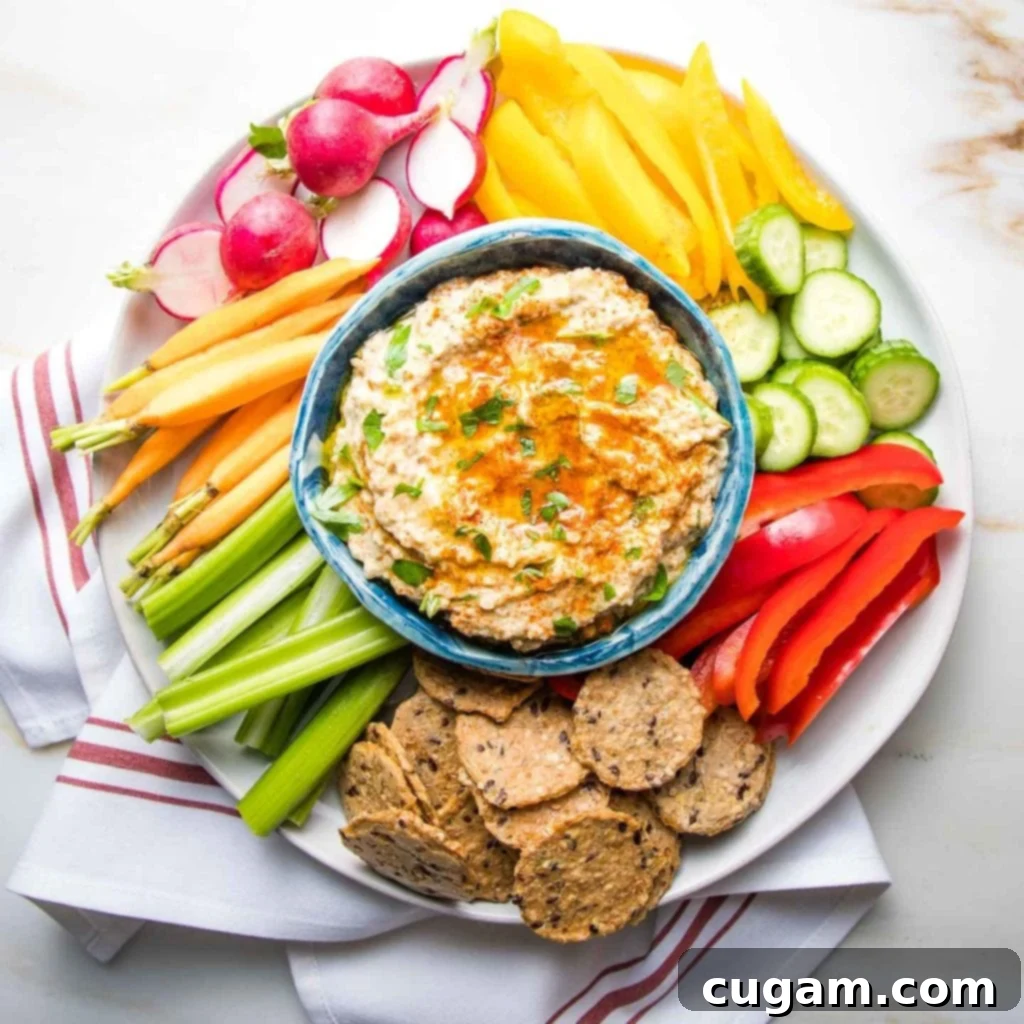
Now that you’ve mastered the art of making the best Baba Ganoush, here are some expert tips to ensure every serving is a showstopper and perfectly suited to your taste:
- Perfect Presentation: For an irresistible finish, transfer your creamy Baba Ganoush to a serving bowl. Create a small well in the center, then generously drizzle with a high-quality extra virgin olive oil. Finish with a vibrant sprinkle of sweet paprika or a dash of zesty za’atar, and a scattering of freshly chopped flat-leaf parsley. These garnishes not only add visual appeal but also enhance the overall flavor experience.
- Hand-Mashing for Texture: If you’re opting for a more rustic, chunky Baba Ganoush and mashing by hand, ensure your onions and celery are diced into exceptionally small pieces before sautéing. This will help achieve a more uniform (though still textured) consistency without large, raw-feeling chunks.
- A Heartier Dish: For an unexpectedly delicious and more substantial meal, consider topping your Baba Ganoush with a few scoops of flavorful vegan ground beef. This adds a wonderful savory element and transforms the dip into a satisfying dish on its own.
- Flavor Adjustments: Always taste and adjust! If you crave more zing, add an extra squeeze of fresh lemon juice. For those who appreciate a kick, a pinch of cayenne pepper can provide a delightful warmth. Don’t be afraid to customize the salt and pepper to your preference.
- Serving Temperature: Baba Ganoush is incredibly versatile. It can be served warm, at room temperature, or chilled. Each temperature offers a slightly different experience, with flavors becoming more pronounced as it sits.
- Storage: Store any leftover Baba Ganoush in an airtight container in the refrigerator for up to 5 days. The flavors often deepen and meld beautifully overnight, making it even more delicious the next day.
Now that you’ve had the chance to experience this truly exceptional Baba Ganoush recipe, I’m eager to hear your verdict! Are you still firmly on Team Hummus, or has this smoky, creamy, and flavorful roasted eggplant dip swayed your allegiance? I have a strong suspicion that once you taste what I confidently call “THE BEST,” you’ll find yourself reaching for Baba Ganoush more often. Perhaps if you’ve also tried my equally delicious cauliflower hummus, which also features the magic of roasted garlic, the choice might be a delightful struggle – a dilemma I often face myself! Share your thoughts and tell me which dip reigns supreme in your kitchen in the comments below.
Your engagement means the world! Did you know that leaving comments and rating recipes is one of the most impactful ways to support your favorite food bloggers? If you’ve enjoyed making and tasting this incredible Baba Ganoush, please take a moment to consider leaving a five-star rating below and sharing your feedback in a comment. We’d also absolutely love to see your culinary creations! Please share your photos on Instagram by tagging me @dkhealthcoach and using the hashtag #debraklein. Your shares inspire us and help others discover delicious, healthy recipes!
📖 Recipe
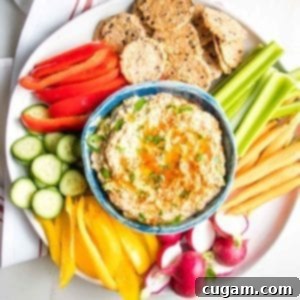
Baba Ganoush with Roasted Garlic and Tahini
Debra Klein
Rate this Recipe
Pin Recipe
5 minutes
30 minutes
5 minutes
40 minutes
Appetizer
Middle Eastern
8
servings
158
kcal
Equipment
-
Food Processor
-
Cast iron skillet
-
Extra Large Bamboo Cutting Board
-
Global 8″ Chef’s Knife
-
Parchment Baking Paper
-
Half Sheet Baking Pans
Ingredients
-
2
lbs.
eggplant* -
2
Tablespoons
olive oil
divided -
6
cloves
garlic
skins still on -
1
medium onion*
diced -
2
ribs celery*
diced -
¼
cup
tahini -
¼
cup
fresh lemon juice* -
1
teaspoon
ground cumin -
½
teaspoon
coarse sea salt -
¼
teaspoon
white pepper*
Instructions
-
Preheat your oven to 400°F (200°C). Line a large, rimmed baking tray with unbleached parchment paper for easy cleanup and to prevent sticking.
-
Carefully cut the eggplant(s) in half lengthwise. Drizzle the cut side generously with 1 tablespoon of olive oil, then place them cut-side down on the prepared baking tray. Scatter the whole garlic cloves, with their skins still on, evenly around the eggplant on the same tray. Roast for 30-40 minutes; the exact time will vary based on the size of your eggplants. You’ll know they are done when the eggplant sides start to cave in, and the flesh is exceptionally tender and easily pierced with a fork.
-
Meanwhile, finely dice the onion and celery. Heat a cast iron or other heavy-bottomed skillet over medium-low heat. Swirl in the remaining 1 tablespoon of olive oil, then add the diced onions and celery. Cook until they are soft and beginning to caramelize, which should take about 8-10 minutes, stirring occasionally. This slow cooking will bring out their natural sweetness. Transfer the cooked veggies to the bowl of a food processor.
-
Once the eggplant is completely cooked and cool enough to handle, its skin will be collapsed and the inside perfectly tender. Using a large spoon, scoop out all the smoky eggplant flesh and add it to the food processor with the caramelized veggies. Squeeze the soft roasted garlic pulp from their skins directly into the processor bowl as well. Process until thoroughly mixed and the mixture is coarsely chunky. Then, add the tahini, fresh lemon juice, ground cumin, coarse sea salt, and white pepper. Process until the dip is smooth and creamy, pausing to scrape down the sides a few times to ensure everything is well combined.
-
Taste your Baba Ganoush for seasoning. Add additional salt and pepper as desired to perfectly balance the flavors. If the eggplant dip is too thin for your preference, add a bit more tahini, one tablespoon at a time, and process again. If it’s too thick, a touch more lemon juice or a tablespoon of water can help achieve a smoother consistency.
-
Serve warm, at room temperature, or allow to chill in the refrigerator for at least 30 minutes before serving. For a beautiful presentation, make a well in the center of the dip, drizzle generously with a high-quality olive oil, and sprinkle with sweet paprika, a dash of chili powder, or aromatic za’atar. Baba Ganoush will stay fresh and delicious in an airtight container in the fridge for up to 5 days.
Notes
Onion Yield: One medium onion, when finely diced, generally yields approximately ½ cup, which is the perfect amount for this recipe’s caramelization process.
Celery Measurement: Two medium celery ribs should produce about ½ cup of diced celery. If your celery stalks are on the smaller side, you might need to use three to achieve the desired quantity and flavor contribution.
Adjusting Tanginess: The ¼ cup of fresh lemon juice provides a balanced tang. However, if you prefer a more vibrant and zesty dip, feel free to add an additional tablespoon of fresh lemon juice, tasting as you go to reach your ideal flavor profile.
Spice Level: This recipe uses ¼ teaspoon of white pepper for a subtle warmth. If you enjoy a dip with a bit more underlying heat, consider increasing the white pepper to ½ teaspoon, or even adding a tiny pinch of cayenne pepper for a spicier kick.
Garnish Ideas: Elevate your Baba Ganoush presentation with simple yet impactful garnishes. Consider a sprinkle of finely minced fresh flat-leaf parsley for herbaceous freshness, a dash of sweet paprika or exotic za’atar for color and aroma, a generous drizzle of high-quality extra virgin olive oil, and a few fresh lemon wedges for an extra burst of citrus.
Versatile Serving Suggestions: Baba Ganoush is incredibly versatile. Serve it traditionally with warm, toasted pita wedges, an assortment of your favorite crackers, or a colorful array of fresh crudités like bell peppers, carrots, cucumbers, and radishes. It’s also a fantastic addition to a full Mediterranean falafel plate or as a spread inside a pita wrap.
Nutrition
Serving:
1
g
Calories:
158
kcal
Carbohydrates:
14
g
Protein:
5
g
Fat:
10
g
Saturated Fat:
2
g
Polyunsaturated Fat:
7
g
Cholesterol:
9
mg
Sodium:
149
mg
Fiber:
4
g
Sugar:
5
g
Note
The nutrition calculations were done using online tools. To obtain the most accurate representation of the nutritional information in any given recipe, you should calculate the nutritional information with the actual ingredients you used. You are ultimately responsible for ensuring that any nutritional information is accurate, complete and useful.
Did you make this recipe?
Please leave a review below, then snap a picture and tag me @dkhealthcoach or use hashtag #dkhealtcoach on Instagram so I can see it!!
